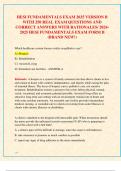HESI FUNDAMENTALS EXAM 2025 VERSION B
WITH 250 REAL EXAM QUESTIONS AND
CORRECT ANSWERS WITH RATIONALES/ 2024-
2025 HESI FUNDAMENTALS EXAM FORM B
(BRAND NEW!)
Which healthcare system focuses solely on palliative care?
A.) Hospice
B.) Rehabilitation
C.) Assisted Living
D.) Extended care facilities - ANSWER-A
Rationale: A hospice is a system of family-centered care that allows clients to live
and remain at home with comfort, independence, and dignity while easing the pain
of terminal illness. The focus of hospice care is palliative care, not curative
treatment. Rehabilitation restores a person to his or her fullest physical, mental,
social, vocational, and economic potential possible. Assisted living offers an
attractive long-term care setting with an environment reminiscent of home and
with some resident autonomy. An extended care facility provides intermediate
medical, nursing, or custodial care to clients recovering from acute illnesses or
clients with chronic illnesses or disabilities.
A client is admitted to the hospital with intractable pain. When instruction should
the nurse provide the unlicensed assistive personnel (UAP) who is preparing to
assist this client with a bed bath?
A. a client's pain will be difficult to manage, since the cause is still unknown
B. take measures to promote as much comfort as possible
C. report any signs of drug addiction to the nurse immediately
pg. 1
,D. wait until the client's pain is gone before assisting with personal care -
ANSWER-B. take measures to promote as much comfort as possible
A male client arrives at the out patient surgery center for a scheduled needle
aspiration of the knee. He tells the nurse that he has already given verbal consent
for the procedure to the health care provider. What action should the nurse
implement?
A. verify the client's consent with the health care provider
B. document that the client has given consent for the needle aspiration
C. witness the client's signature on the consent form
D. notify the healthcare provider that the client is ready for the procedure -
ANSWER-C. witness the client's signature on the consent form
A low-sodium, low-protein diet is prescribed for a 45-year-old client with renal
insufficiency and hypertension, who gained 3 pounds in the last month. The nurse
determines that the client has been noncompliant with the diet, based on which
report from the 24-hour dietary recall? (Select all that apply.)
A.) Snack of potato chips, and diet soda.
B.) Lunch of tuna fish sandwich, carrot sticks, fresh fruit, and coffee.
C.) Breakfast of eggs, bacon, toast, and coffee.
D.) Dinner of vegetable lasagna, tossed salad, sherbet, and iced tea.
E.) Bedtime snack of crackers and milk. - ANSWER-A, B, C, E
Rationale: Potato chips (A) are high in sodium. Tuna (B) is high in protein. Bacon
(C) and crackers (E) are high in sodium. Only (D) is a meal that is in compliance
with a low sodium, low protein diet.
pg. 2
,Which technique is most important for the nurse to implement when performing a
physical assessment?
A.) A head-to-toe approach.
B.) The medical systems model.
C.) A consistent, systematic approach.
D.) An approach related to a nursing model. - ANSWER-C
Rationale: The most important factor in performing a physical assessment is
following a consistent and systematic technique (C) each time an assessment is
performed to minimize variation in sequence which may increase the likelihood of
omitting a step or exam of an isolated area. The method of completing a physical
assessment (A, B, and D) may be at the discretion of the examiner, but a consistent
sequence by the examiner provides a reliable method to ensure thorough review of
the clients' history, complaints, or body systems.
The nurse is evaluating client learning about a low-sodium diet. Selection of which
meal would indicate to the nurse that this client understands the dietary
restrictions?
A.) Tossed salad, low-sodium dressing, bacon and tomato sandwich.
B.) New England clam chowder, no-salt crackers, fresh fruit salad.
C.) Skim milk, turkey salad, roll, and vanilla ice cream.
D.) Macaroni and cheese, diet Coke, a slice of cherry pie. - ANSWER-C
Rationale: Skim milk, turkey, bread, and ice cream, while containing some
sodium, are considered low-sodium foods. Bacon, canned soups, especially those
with seafood, hard cheeses, macaroni, and most diet drinks are very high in
sodium.
pg. 3
, A female nurse who sometimes tries to save time by putting medications in her
uniform pocket to deliver to clients, confides that after arriving home she found a
hydrocodone (Vicodin) tablet in her pocket. Which possible outcome of this
situation should be the nurse's greatest concern?
A.) Accused of diversion.
B.) Reported for stealing.
C.) Reported for a HIPAA violation.
D.) Accused of unprofessional conduct. - ANSWER-A
Rationale: Even if this is only one incident, the nurse may be suspected of taking
medications on a regular basis and the incident could be interpreted as diversion
(A), or diverting narcotics for her own use, which should be reported to the peer
review committee and to the State Board of Nursing. (B, C, and D) are also of
concern, but (A) is the most serious possible outcome.
A male client has a nursing diagnosis of "spiritual distress." What intervention is
best for the nurse to implement when caring for this client?
A.) Use distraction techniques during times of spiritual stress and crisis.
B.) Reassure the client that his faith will be regained with time and support.
C.) Consult with the staff chaplain and ask that the chaplain visit with the client.
D.) Use reflective listening techniques when the client expresses spiritual doubts. -
ANSWER-D
Rationale: The most beneficial nursing intervention is to use nonjudgmental
reflective listening techniques, to allow the client to feel comfortable expressing
pg. 4




